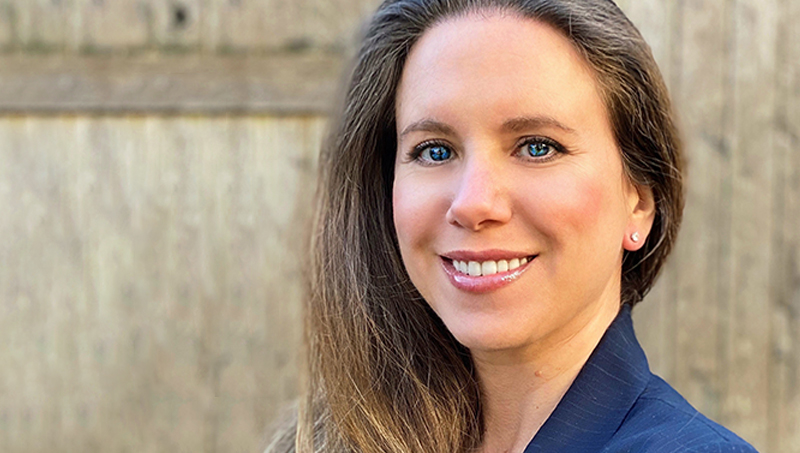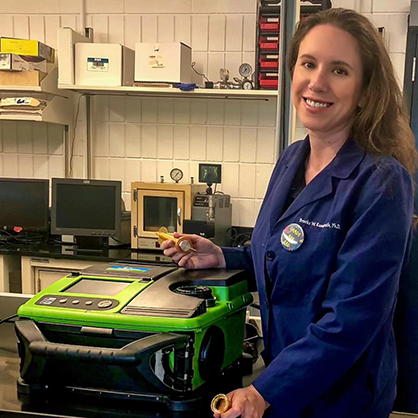
The Charger Blog
Computer Science Student’s Guide to Getting Through Finals Season
Charger Shana-Kay Hyde ’27 shares what she’s learned about planning, studying, and taking care of herself during finals.
The Charger Blog
Brooke Kammrath, Ph.D., D-ABC, is excited to serve as associate editor for the Journal of Forensic Sciences – and to continue to make an important impact in forensic science research.
March 29, 2022

Brooke Kammrath, Ph.D., D-ABC, is passionate about forensic science research – whether it is conducting her own or mentoring her students’ explorations. She is now making an impact on the research of fellow colleagues in the field as a new associate editor for the Journal of Forensic Sciences (JFS).
A prestigious peer-reviewed journal, JFS is the official publication of the American Academy of Forensic Sciences. Dr. Kammrath endeavors to contribute to the publication’s advancement by ensuring that it continues to maintain the highest-quality manuscripts. She also plans to increase its presence on social media, something she believes is an important resource for sharing information.
“I was incredibly honored to be asked to take on the role of associate editor, as it demonstrates the respect that I have earned in the field of forensic science,” said Dr. Kammrath, a forensic science professor at the University and an assistant director of the Henry C. Lee Institute of Forensic Science. “JFS is one of the most respected journals in the field of forensic science, and it is very exciting to play such an important role in the peer-review process. Peer review is a critical component of research, as it ensures integrity in the knowledge being advanced.”
Peer review and the research process are areas that Dr. Kammrath knows well. She describes her own research agenda as “diverse,” and she is currently involved in a dozen different projects in various stages. Her interests include uniting microscopy with spectroscopy and the statistical analysis of trace, pattern, and impression evidence.
“What I like most about forensic science is that it uses a diverse array of scientific principles, methods, and technologies to solve unique problems,” she explains. “Every crime scene is different, and so is each physical-evidence trace. I love the critical thinking and scientific problem solving required to be a quality criminalist.”
Currently researching a variety of different topics including illicit drug mixtures, forensic paint analysis, and DNA degradation of bloodstains due to Raman Spectroscopy, Dr. Kammrath’s work includes several of her colleagues at the University, including Angie Ambers, Ph.D., David San Pietro, Ph.D., Virginia Maxwell, D.Phil., and Koby Kizzire, Ph.D.

Dr. Kammrath also collaborates with forensic technology companies, as well as researchers from other prestigious universities such as John Jay College of Criminal Justice. She is currently conducting forensic soil analysis with particle-correlated Raman Spectroscopy, research being funded by a grant of approximately $700,000 from the National Institute of Justice.
A leader in the field of forensic science, Dr. Kammrath is also involved with myriad professional forensic science and chemistry societies, including the Northeastern Association of Forensic Scientists, the American Academy of Forensic Sciences, and the Society for Applied Spectroscopy.
“I know that my research collaborations, involvement in professional forensic science and chemistry societies, and overall networking have opened many doors for my student scientists,” she said. “It helps them in terms of obtaining internships, funded-research positions in doctoral programs, and landing their first jobs.”
Her many collaborations have enabled Dr. Kammrath to create a variety of exciting and hands-on opportunities for her students. They work with cutting-edge technology, something that has, in many cases, been made possible by her professional affiliations as well as federal grants.
Students are also a critical component of Dr. Kammrath’s research, as all of her research includes student scientists. They have presented their findings at conferences, including the Northeastern Association of Forensic Scientists Annual Meeting during the Fall semester. One of her students, Cody Silverman ’22, was recognized at the conference and has earned two professional research grants to pursue his work.
For Dr. Kammrath, it is the opportunities she has to mentor her students and create opportunities for them to excel and grow as scientists that she enjoys the most about her work.
“I have a pretty well-defined research agenda that provides my students with the opportunity to work on a range of physical-evidence traces, including soil, paint, fibers, illicit drugs, explosives, and more,” she said. “The best part of my work is mentoring student scientists. The amazing undergraduate and graduate student scientists I get to work with keep every day different, exciting, and fulfilling.”

The Charger Blog
Charger Shana-Kay Hyde ’27 shares what she’s learned about planning, studying, and taking care of herself during finals.

The Charger Blog
Supported by the Bartels family, the Hatfield Scholars Program continues its mission of recognizing students who excel in the classroom and who uplift the Charger community.

The Charger Blog
Charger Blogger Beatrice Glaviano ’26 chats with her boyfriend, a fellow Charger, about studying paramedicine, finding balance, and his plans after graduation, while consuming plenty of peanut butter M&Ms.